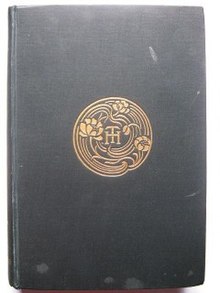
Mary Anning was an English fossil collector, dealer, and palaeontologist. She became known internationally for her discoveries in Jurassic marine fossil beds in the cliffs along the English Channel at Lyme Regis in the county of Dorset, Southwest England. Anning's findings contributed to changes in scientific thinking about prehistoric life and the history of the Earth.
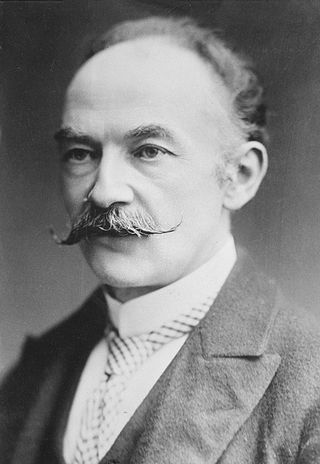
Thomas Hardy was an English novelist and poet. A Victorian realist in the tradition of George Eliot, he was influenced both in his novels and in his poetry by Romanticism, including the poetry of William Wordsworth. He was highly critical of much in Victorian society, especially on the declining status of rural people in Britain such as those from his native South West England.

Lyme Regis is a town in west Dorset, England, 25 miles (40 km) west of Dorchester and east of Exeter. Sometimes dubbed the "Pearl of Dorset", it lies by the English Channel at the Dorset–Devon border. It has noted fossils in cliffs and beaches on the Jurassic Coast, a World Heritage Site and heritage coast. The harbour wall, known as The Cobb, appears in Jane Austen's novel Persuasion, the John Fowles novel The French Lieutenant's Woman and the 1981 film of that name, partly shot in the town.

Jude the Obscure is a novel by Thomas Hardy, which began as a magazine serial in December 1894 and was first published in book form in 1895. It is Hardy's last completed novel. The protagonist, Jude Fawley, is a working-class young man; he is a stonemason who dreams of becoming a scholar. The other main character is his cousin, Sue Bridehead, who is also his central love interest. The novel is concerned in particular with issues of class, education, religion, morality and marriage.

The Isle of Portland is a tied island, 6 kilometres (4 mi) long by 2.7 kilometres (1.7 mi) wide, in the English Channel. The southern tip, Portland Bill, lies 8 kilometres (5 mi) south of the resort of Weymouth, forming the southernmost point of the county of Dorset, England. A barrier beach called Chesil Beach joins Portland with mainland England. The A354 road passes down the Portland end of the beach and then over the Fleet Lagoon by bridge to the mainland. The population of Portland is 13,417.
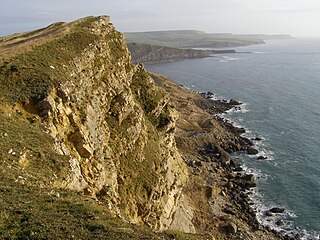
The Jurassic Coast is a World Heritage Site on the English Channel coast of southern England. It stretches from Exmouth in East Devon to Studland Bay in Dorset, a distance of about 96 miles (154 km), and was inscribed on the World Heritage List in mid-December 2001.

Chesil Beach in Dorset, England is one of three major shingle beach structures in Britain. Its name is derived from the Old English ceosel or cisel, meaning "gravel" or "shingle". It runs for a length of 29 kilometres (18 mi) from West Bay to the Isle of Portland and in places is up to 15 metres (50 ft) high and 200 metres (660 ft) wide. Behind the beach is the Fleet, a shallow tidal lagoon. Both are part of the Jurassic Coast and a UNESCO World Heritage Site, and together form an SSSI and Ramsar Site.

The Mayor of Casterbridge: The Life and Death of a Man of Character is an 1886 novel by the English author Thomas Hardy. One of Hardy's Wessex novels, it is set in a fictional rural England with Casterbridge standing in for Dorchester in Dorset where the author spent his youth. It was first published as a weekly serialisation from January 1886.

Under the Greenwood Tree: A Rural Painting of the Dutch School is a novel by the English writer Thomas Hardy, published anonymously in 1872. It was Hardy's second published novel, and the first of what was to become his series of Wessex novels. Critics recognise it as an important precursor to his later tragic works, setting the scene for the Wessex that the author would return to again and again. Hardy himself called the story of the Mellstock Quire and its west-gallery musicians "a fairly true picture, at first hand, of the personages, ways, and customs which were common among such orchestral bodies in the villages of [the 1850s]".
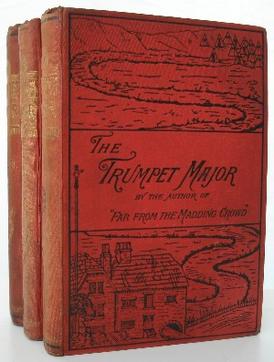
The Trumpet-Major is a novel by Thomas Hardy published in 1880, and his only historical novel. Hardy included it with his "romances and fantasies". It concerns the heroine, Anne Garland, being pursued by three suitors: John Loveday, the eponymous trumpet major in a British regiment, honest and loyal; his brother Bob, a flighty sailor; and Festus Derriman, the cowardly nephew of the local squire. Unusually for a Hardy novel, the ending is not entirely tragic; however, there remains an ominous element in the probable fate of one of the main characters.

Wakeham is a hamlet near the village of Easton, in Tophill on the Isle of Portland in Dorset, England. It is situated between the Straits part of Easton, and Pennsylvania Castle. As with the rest of Portland's villages and settlements, Wakeham has been designated as a conservation area, as it is a place of special architectural and historic interest. Easton, Wakeham and Reforne were designated pre-1974. The hamlet features a distinctively wide road running through it, once built to allow space for horse-drawn carts transporting stone by road. Many of Wakeham's older buildings of the 17th and 18th century survive.
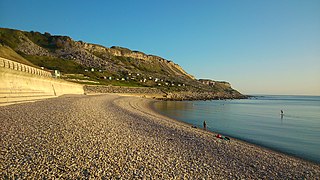
Chesil Cove is a curved steep bank forming the south-east end of 29-kilometre (18 mi) Chesil Beach in Dorset, England. It is thus part of one of three large shingle structures in Britain, extending from West Bay to the Isle of Portland, the latter acting more firmly as a great barrier (groyne) which stops tidal action from washing the beach away and leads to the high depositions by wind and tide action forming the grand curved bank of this "cove". The "cove", bill and much of Chesil Beach give shelter from the prevailing winds and waves for much of Weymouth Bay, the town of Weymouth and the village of Chiswell. It forms part of the Jurassic Coast.

Thomas Hardy's Wessex is the fictional literary landscape created by the English author Thomas Hardy as the setting for his major novels, located in the south and southwest of England. Hardy named the area "Wessex" after the medieval Anglo-Saxon kingdom that existed in this part of that country prior to the unification of England by Æthelstan. Although the places that appear in his novels actually exist, in many cases he gave the place a fictional name. For example, Hardy's home town of Dorchester is called Casterbridge in his books, notably in The Mayor of Casterbridge. In an 1895 preface to the 1874 novel Far from the Madding Crowd he described Wessex as "a merely realistic dream country".
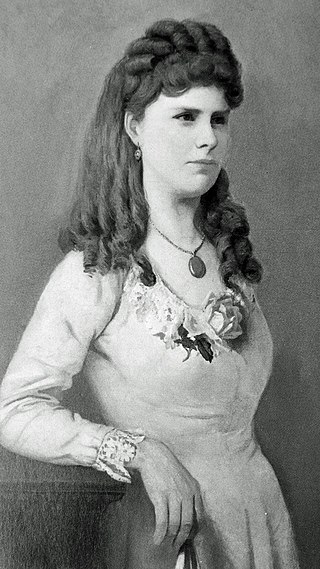
Emma Lavinia Gifford was an English writer and suffragist. She was also the first wife of the novelist and poet Thomas Hardy.
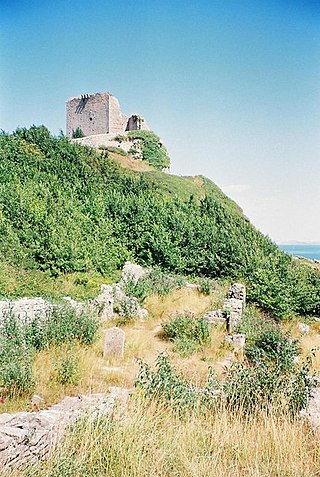
Rufus Castle, also known as Bow and Arrow Castle, is a partially ruined castle overlooking Church Ope Cove on Portland, England. Its name derives from King William II, known as William Rufus, for whom the original castle was built.
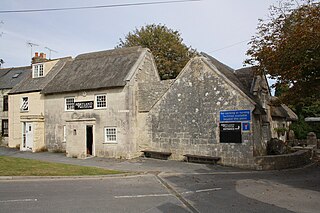
Portland Museum is a museum on the Isle of Portland in Dorset, southern England. It is located at the southern end of the hamlet of Wakeham. The museum is housed in two 17th-century thatched cottages, which have both been Grade II Listed since 1951. One of the museum's cottages, Avice's Cottage, is featured in Thomas Hardy's 1897 novel The Well-Beloved, as the home of three generations of "Avices" - the novel's heroines.
Dorset is a county in South West England on the English Channel coast. The ceremonial county comprises the area covered by the non-metropolitan county, which is governed by Dorset Council, together with the unitary authorities of Poole and Bournemouth. Dorset is an average sized county with an area of 2,653 square kilometres (1,024 sq mi); it borders Devon to the west, Somerset to the north-west, Wiltshire to the north-east, and Hampshire to the east. Around half of Dorset's population lives in the South East Dorset conurbation. The rest of the county is largely rural with a low population density.

Pennsylvania Castle is a Gothic Revival mansion on the Isle of Portland, Dorset, England. It is located in Wakeham and overlooks Church Ope Cove. The castle is Grade II Listed, as is the adjacent gatehouse and lodges, which are now in separate ownership.

Phillip King PRA was a British sculptor. He was one of Anthony Caro's best-known students, even though the two artists were near contemporaries. Their education followed similar trajectories and they both worked as assistants to Henry Moore. Following the "New Generation" show at the Whitechapel Gallery, both Caro and King were included in the seminal 1966 exhibit, "Primary Structures" at the Jewish Museum in New York representing the British influence on the "New Art". In 2011, his work was represented in the Royal Academy exhibition on Modern British Sculpture which explored British sculpture of the twentieth century.
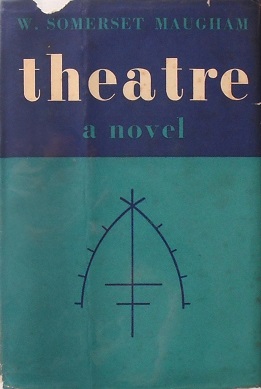
Theatre is a novel by the British writer W. Somerset Maugham, first published in 1937 by William Heinemann (UK) and Doubleday Doran (US).
